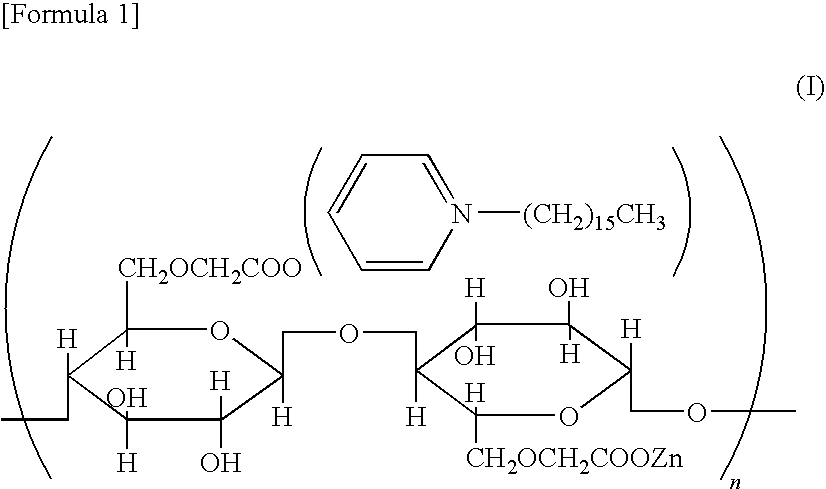Antimicrobial fiber and its production method, and antimicrobial fiber product comprising the antimicrobial fiber, its production method and regeneration method
- Summary
- Abstract
- Description
- Claims
- Application Information
AI Technical Summary
Benefits of technology
Problems solved by technology
Method used
Image
Examples
example 1
[0138]A bandage of a spun-bond nonwoven fabric formed of a continuous fiber of cuprammonium rayon was dipped in an aqueous solution of sodium monochloroacetate and sodium hydroxide dissolved therein, then dewatered to a suitable dewatering ratio, and dried to be in an absolute dry condition, thereby obtaining a bandage in which a part of the hydroxy group of the cellulose fiber was sodium carboxymethylated.
[0139]Subsequently, the bandage was dipped and neutralized in an aqueous solution of zinc sulfate heptahydrate, acetic acid and sodium acetate dissolved therein, and simultaneously the sodium carboxymethyl group was converted into a zinc-carboxymethyl group. Afterwards, the remaining zinc sulfate, acetic acid and sodium acetate were removed by washing with water, and this was dried to give a bandage in which a part of the hydroxy group of the cellulose fiber was zinc-carboxymethylated.
[0140]Next, the above zinc-carboxymethylated bandage was dipped in an aqueous cetylpyridinium chl...
example 2
[0142]In the same manner as in Example 1 but using a nonwoven fabric of a lyocell fiber in place of the cuprammonium rayon nonwoven fabric and using silver nitrate in place of zinc sulfate heptahydrate, obtained was a bandage in which a part of the carboxy group bonding to the cellulose fiber (carboxy group of the carboxyalkylated cellulose fiber) was silver-carboxymethylated and another part was cetylpyridinium-carboxymethylated. The bandage was evaluated for various characteristics. The results are shown in Table 1.
example 3
[0143]In the same manner as in Example 1 but using a nonwoven fabric of a viscose rayon fiber in place of the cuprammonium rayon nonwoven fabric and using copper sulfate pentahydrate in place of zinc sulfate heptahydrate, obtained was a bandage in which a part of the carboxy group bonding to the cellulose fiber (carboxy group of the carboxyalkylated cellulose fiber) formed a copper salt and another part formed a cetylpyridinium salt. The bandage was evaluated for various characteristics. The results are shown in Table 1.
PUM
| Property | Measurement | Unit |
|---|---|---|
| Molality | aaaaa | aaaaa |
| Molality | aaaaa | aaaaa |
| Antimicrobial properties | aaaaa | aaaaa |
Abstract
Description
Claims
Application Information
 Login to View More
Login to View More - R&D
- Intellectual Property
- Life Sciences
- Materials
- Tech Scout
- Unparalleled Data Quality
- Higher Quality Content
- 60% Fewer Hallucinations
Browse by: Latest US Patents, China's latest patents, Technical Efficacy Thesaurus, Application Domain, Technology Topic, Popular Technical Reports.
© 2025 PatSnap. All rights reserved.Legal|Privacy policy|Modern Slavery Act Transparency Statement|Sitemap|About US| Contact US: help@patsnap.com

